- Your cart is empty
- Continue Shopping

The History of the Sambadrome: The Heart of Rio's Carnival
Rio de Janeiro’s Carnival is one of the world’s greatest cultural events, renowned for its grandeur, exuberance, and the passion that moves millions of people. At the center of this celebration is the Sambadrome of Marquês de Sapucaí, a monumental structure that has become synonymous with Rio’s Carnival. This article explores the history of the Sambadrome, from its conception to its central role in celebrating the greatest show on Earth.
The Origins of Carnival in Rio de Janeiro
Before we dive into the history of the Sambadrome, it is important to understand how Carnival evolved in Rio de Janeiro. Carnival The carioca tradition has its roots in the 18th century, with influences from European traditions of masked dances and parades, which were mixed with African and indigenous cultures over the years. This fusion gave rise to Carnival as we know it today: a popular, vibrant and multicultural celebration.
The first carnival events in Rio included the entrudos, popular festivals where people threw water, flour and other liquids at each other. Over time, these celebrations evolved into cordões, ranchos and, finally, samba schools, which began to emerge in the early 20th century.
The Need for a Dedicated Space
With the growth of samba schools and the popularity of parades, the need for a dedicated space for these performances became evident. In the 1930s, parades were held on the streets of downtown Rio de Janeiro, such as Avenida Rio Branco, but the lack of adequate infrastructure and the increase in audiences made these locations increasingly impractical.
It was only in the 1980s that the idea of an exclusive space for samba school parades began to take shape. With the growing popularity of the parades, which were already broadcast on television throughout Brazil, the need for a fixed location that offered comfort to the public and adequate infrastructure for the schools became urgent.
The Conception of the Sambadrome
In 1983, the city of Rio de Janeiro was under the administration of Governor Leonel Brizola, who, recognizing the cultural and economic importance of Carnival, decided it was time to build a permanent space for the samba school parades. To this end, he called on renowned Brazilian architect Oscar Niemeyer, famous for his modernist works, to design the Sambadrome.
Niemeyer, known for his bold and innovative architectural style, accepted the challenge and created a project that would transform the Samba Walkway into a true avenue for the spectacle. The chosen location was Avenida Marquês de Sapucaí, in downtown Rio de Janeiro, an area that had already been used for samba school parades in previous years.
Niemeyer's project was ambitious: a 700-meter-long avenue lined with fixed stands that would accommodate thousands of spectators. Construction began in 1983 and, surprisingly, was completed in less than a year, officially opening on March 2, 1984.
The First Parade at the Sambadrome
The inauguration of the Sambadrome coincided with the 1984 samba school parade, which went down in history as the first to be held in the new space. The impact was immediate: the fixed stands provided a better view of the parade for the public, and the structure allowed the samba schools to present their shows with greater freedom and creativity.
On that first night, Beija-Flor de Nilópolis was the first school to parade, inaugurating the Samba Runway. Since then, the Sambadrome has become the epicenter of Rio's Carnival, a place where tradition, art and culture come together in a spectacle of epic proportions.
The Sambadrome and the Development of Carnival
Over the years, the Sambadrome has undergone several renovations and expansions to improve the experience for both the public and parade participants. In 2011, a major renovation was carried out to increase the Sambadrome's capacity and improve its facilities, preparing it for the international events that Rio de Janeiro would host, such as the 2014 World Cup and the 2016 Olympics.
In addition to Carnival parades, the Sambadrome has also hosted a number of cultural events and concerts, making it one of Rio de Janeiro's main tourist attractions. During the 2016 Olympic Games, the Sambadrome was used for archery competitions, highlighting its versatility as a public space.
The Sambadrome in Popular Culture
The Sambadrome is not just a physical place; it is a symbol of Brazilian popular culture. Every year, millions of people watch the samba school parades on television, and for many Brazilians, the Sambadrome represents the pinnacle of Carnival. The images of packed stands, gigantic floats and lavish costumes are known around the world.
For samba schools, the Sambadrome is the stage where months of preparation, rehearsals and dedication culminate in a performance that will be rigorously judged. Each parade at the Sambadrome is a fierce competition, where the schools seek to impress the judges and the audience, with the hope of winning the title of Carnival champion.
The Future of the Sambadrome
The Marquês de Sapucaí Sambadrome continues to evolve. With the changing dynamics of the samba schools and the growing demand for innovation in parades, the Sambadrome remains a space in constant transformation. The modernization of its facilities and the expansion of its capacity are recurring themes, but the focus will always be on maintaining the balance between tradition and innovation.
With the growing popularity of Rio de Janeiro Carnival around the world, the Sambadrome has established itself as one of Brazil’s greatest cultural icons. It is not just a parade ground, but the beating heart of a festival that celebrates the diversity, creativity and joy of the Brazilian people.
The Sambadrome of Marquês de Sapucaí is much more than a physical space; it is the epicenter of Rio de Janeiro's Carnival, a place where history, culture and emotion meet. Since its conception by Oscar Niemeyer to this day, the Sambadrome has become the ultimate symbol of Rio's Carnival, a place where the magic of samba becomes reality.
For those who participate in the parades, the Sambadrome is a stage of dreams; for those who watch, it is a window into the culture and soul of Brazil. Over the years, the Sambadrome has evolved, but its essence as the heart of Rio's Carnival remains unshakable. It is here, on this legendary avenue, that the history of Carnival continues to be written, year after year, in a spectacle that enchants the entire world.

